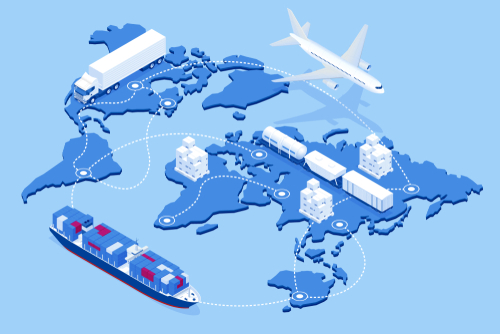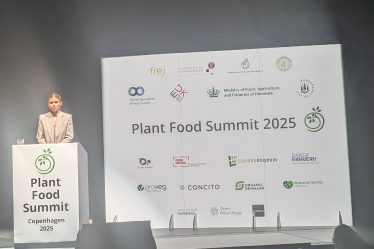
Few industries feel disruption as sharply as food and beverage. In this expert feature, global supply chain influencer Maria Villablanca explores how digital transformation – from blockchain to AI – is driving greater food and beverage supply chain resilience, helping businesses build transparency, predict risk and safeguard production in an era of constant uncertainty.


Building food and beverage supply chain resilience is no longer optional — it is essential for navigating global disruption. Credit: Shutterstock.
Few industries feel the pressure of disruption to building resilient supply chains as acutely as food and beverage. The ability to source, produce and distribute perishable goods hinges on a complex, often fragile, web of suppliers, logistics networks and regulatory frameworks. In an era defined by climate volatility, geopolitical unrest and economic instability, supply chain resilience is no longer a luxury – it is a necessity.
Vulnerabilities in the food & beverage supply chain
The past few years have underscored just how susceptible food supply chains are to external shocks. Consider these ongoing challenges:
- Climate change. Extreme weather events – droughts, floods and hurricanes – are disrupting agricultural yields and creating raw material shortages. For example, Brazil, the world’s largest coffee exporter, saw a 30 percent drop in production in 2021 due to frost and drought conditions, driving prices to a 10-year high.1 Similar issues have impacted wheat production in North America and olive oil supplies in Europe, sending costs soaring.
- Geopolitical instability. Trade disputes, sanctions and conflicts, such as the war in Ukraine, have strained global food supply chains. Wheat shortages and skyrocketing energy costs have left many businesses scrambling for alternatives. Additionally, shifting trade alliances and economic sanctions continue to cause bottlenecks in the global food distribution network.
- Economic pressures. Inflationary costs for fuel, labour and raw materials are squeezing margins. Meanwhile, shifting consumer preferences and regulatory compliance add layers of complexity to supply-chain decisionmaking. Rising interest rates and global recession fears have also led companies to reconsider their supply strategies, balancing cost efficiency with risk mitigation.
With these risks escalating, the question is: How can food and beverage companies build resilience into their supply chains?
The digital transformation of supply chains
Enter digital transformation. Technologies such as blockchain, the Internet of Things (IoT) and artificial intelligence (AI) are reshaping supply chain management, providing the transparency, predictive insights and automation needed to mitigate risks.
Blockchain – the key to traceability and trust
Blockchain technology offers end-to-end visibility and traceability, ensuring that food products move securely and transparently across the supply chain. By creating an immutable ledger of transactions, blockchain prevents fraud, reduces waste and enhances recall efficiency.
Supply chain disruption is inevitable – resilience is the difference between surviving and thriving in the food and beverage industry.”
Walmart implemented a blockchain-based system using IBM’s Food Trust to track the journey of leafy greens. Previously, the process of tracing a product’s origin took seven days but with blockchain, it now takes 2.2 seconds – a game changer for food safety and recall management.2
Beyond safety, blockchain also helps to combat food fraud, which costs the industry billions annually. Companies like Nestlé and Carrefour are using blockchain to allow customers to scan QR codes on food packaging, instantly verifying sourcing and quality.3
IoT: real-time monitoring for perishable goods
IoT sensors provide real-time monitoring of temperature, humidity and storage conditions, reducing spoilage and ensuring food safety compliance. With IoT-enabled logistics, companies can detect deviations immediately and take corrective actions. Maersk’s ‘Captain Peter’ IoT solution enables remote monitoring of refrigerated containers, ensuring consistent cold chain management. This technology has helped reduce spoilage rates for perishable food shipments.4
The use of IoT extends beyond application to transport. Smart warehouses leverage IoT to monitor inventory conditions, automate reordering and prevent spoilage, saving millions in lost goods. Retailers are increasingly adopting IoT to ensure compliance with stringent food safety regulations, improving both efficiency and customer satisfaction.
AI and predictive analytics: anticipating and preventing disruptions
AI and machine learning are revolutionising supply chain forecasting, helping businesses predict demand fluctuations, optimise inventory and proactively address risks.
Nestlé leverages AI to analyse vast amounts of data, which they claim has improved demand forecasting accuracy significantly. This enables more precise production planning, both reducing waste and optimising raw material procurement.
AI-powered predictive maintenance is also improving factory uptime by identifying machinery failures before they happen, ensuring smoother production. Meanwhile, AI-driven risk assessment tools allow companies to simulate various disruption scenarios, helping them to prepare contingency plans.
Building a more resilient future
Supply chain resilience in the food and beverage industry demands a proactive, technology-driven approach. Companies that embrace digital transformation gain a competitive edge on several fronts:
- Enhanced visibility – by leveraging blockchain and IoT for end-to-end traceability, companies are reducing errors and improving recall efficiency
- Improved agility – using AI to anticipate disruptions and optimise decision-making allows businesses to adjust production and sourcing strategies in real time
- Strengthening collaboration – sharing real-time data across stakeholders, including suppliers, distributors and regulators, facilitates improved coordination and response times
- Mitigating risks – diversifying supplier bases and leveraging predictive analytics enables companies to adapt to market volatility, ensuring business continuity even amid global uncertainties
- Investing in localised production – some companies are shifting towards regional sourcing and nearshoring to reduce reliance on long, complex supply chains that are more vulnerable to disruptions
- Automating repetitive tasks – robotic process automation (RPA) is helping supply chain managers streamline order processing, invoice reconciliation and compliance reporting, freeing up time for strategic decision making.
Lessons from resilient companies
While some companies have been caught off guard by disruptions, others have successfully navigated challenges through strategic planning and digital adoption.
- McDonald’s: The fast-food giant has built a highly resilient supply chain, partnering with local suppliers in each market while leveraging global standards. Its multi-tier sourcing strategy has allowed it to maintain product availability even during economic downturns.5
- Unilever: The company’s sustainability-focused supply chain integrates IoT and blockchain for improved tracking of raw materials, ensuring compliance with ethical sourcing requirements.6
Conclusion
The modern supply chain is at an inflection point. While vulnerabilities persist, food and beverage companies that invest in technology, transparency and automation will emerge stronger and more resilient. The question is not whether disruption will happen but how prepared your business will be when it does.
By embracing digital transformation, the food industry can shift from reacting to disruptions to anticipating and mitigating them, ensuring stable, efficient and sustainable supply chains for the future. The companies that act now will not only weather the next crisis but also gain a competitive advantage in an increasingly unpredictable world.
References:
1.Miller E. The Big Brazil Frost [Internet]. Global Coffee Report. 2021. Available from: https://www.gcrmag.com/brazil-frost/
2. Walmart’s food safety solution using IBM Food Trust built on the IBM Blockchain Platform [Internet]. IBM MediaCenter. Available from:
3. Carrefour – Nestlé Blockchain: Technology for food transparency with Mousline! [Internet]. Carrefour Group. 2024. Available from:
4. Doshi S. Is Cold Chain Logistics the Key to Reducing Food Loss? [Internet]. Maersk.com. 2025 [cited 2025 Apr 7]. Available from:
5. McDonald’s. Food Quality & Sourcing [Internet]. corporate.mcdonalds.com. 2024. Available from:
6. Law M. How Unilever Uses AI & Digital Solutions in its Operations [Internet]. technologymagazine.com. 2024. Available from:
About the author:
Maria Villablanca, global supply chain influencer, Co-founder, Future Insights Network
Maria Villablanca
 is a global supply chain influencer, author and Co-founder of the Future Insights Network. She helps businesses navigate supply chain disruptions through digital transformation, innovation and resilience. As the host of Transform Talks and Voices in Transformation, Maria engages with industry leaders to explore how emerging technologies like AI, blockchain and IoT are reshaping global supply chains. Passionate about storytelling and strategy, she collaborates with executives to drive meaningful change in the food and beverage industry.
is a global supply chain influencer, author and Co-founder of the Future Insights Network. She helps businesses navigate supply chain disruptions through digital transformation, innovation and resilience. As the host of Transform Talks and Voices in Transformation, Maria engages with industry leaders to explore how emerging technologies like AI, blockchain and IoT are reshaping global supply chains. Passionate about storytelling and strategy, she collaborates with executives to drive meaningful change in the food and beverage industry.
Related organisations
Brazil, Carrefour, Future Insights Network, Global Coffee Report, IBM, IBM Food Trust, Maersk, McDonald’s, Nestlé, Technology Magazine, Unilever


